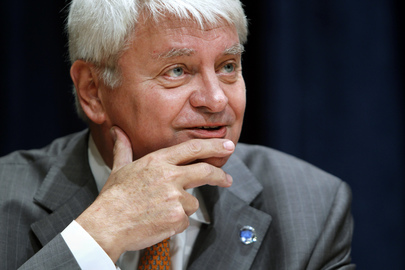At
UN,
Ladsous Shifts
Pibor Dead
from Dozens to
100s,
Inconsistent
with Johnson
By
Matthew
Russell Lee
UNITED
NATIONS,
February 8 --
"Hundreds" of
people were
killed in
Pibor in
Jonglei state,
after the UN
was unable to
transport
"lethal
assets to
dissuade" the
violence due
to a lack of
military
helicopters.
Secretary
General Ban
Ki-moon has
laid the blame
for
this on Russia
for refusing
to fly.
Along with
sexual abuse
and the
introduction
of cholera in
Haiti, it is
one of the
biggest recent
scandals for
the UN
Department of
Peacekeeping
Operations,
headed by
the fourth
Frenchman in a
row, Herve
Ladsous.
Was
the UN
negligent in
not acting
more
forcefully
before the
bloodshed
(after
which it
arranged for
two
Bangladeshi
helicopters
from its Congo
mission)?
Inner City
Press has
repeatedly
been informed,
by Russian
and UN
officials,
that the
Russian made
clear in
mid-November
that
they wouldn't
fly.
But
in a
January
23 video
briefing, UN
envoy to South
Sudan Hilde
Johnson said
that
after the
Russians
notified the
UN of this in
mid November,
after
assurances by
South Sudan it
would comply
with the
Status of
Forces
Agreement, the
Russian flew
"to some team
sites again."
She
continued that
"subsequently"
the Russians
told the UN
they
would not fly.
Inner
City Press
asked again:
when was this
"subsequently"
- when did the
Russians
re-tell the UN
that they
would not fly?
In her second
answer,
Johnson simply
did not answer
this question,
but rather
said
that APCs got
to Pibor
"through the
mud" -- again
without
stating the
timing.
Allowed
a final
round of
questions,
Inner City
Press for a
third time
asked for the
date(s) and
Johnson now
said "we'll
have to get
back to you, I
don't have
that in front
of me."
Since
then,
despite
repeated
requests, no
date has been
provided.
Ban's
spokesman
referred Inner
City Press to
DPKO chief
Ladsous.
February
7 at the
stakeout in
front of the
Security
Council, Inner
City Press
asked
Ladsous for
this
"subsequent"
date. He
answered that
even
though the
Russians had
said they
would not fly,
they were
occupying
space or spots
for
helicopters.
At
Ladsous'
February 8
press
conference,
Inner City
Press asked
Ladsous to
square
his answer
with that of
Hilde Johnson,
and Ban's
claims in his
January 18
speech.
Ladsous now
referred to a
cap on
helicopters.
But
should the UN
have earlier
raised it
voice or "begged"
as
Ban said he
did, some
think far too
late?
Ladsous
said that
the media was
wrong to
report --
based on a
local Jonglei
state
official --
that thousands
had been
killed. He
said that
"hundreds"
were killed.
This varies
from what
Ladsous
previously
said --
"dozens" --
and what
Nesirky's
deputy said,
fifteen.
 (c) UN Photo
(c) UN Photo
Ladsous in the
briefing room
Inner
City Press
asked Nesirky
why the UN had
not provided
this number
updated to
"hundreds" in
a case where
the UN may
bear some
responsibility,
while the UN
is providing
numbers about
other places.
Nesirky said
that Ladsous
had just
provided a
"preview,"
and that more
information
will be
released by
the UN. Watch
this
site.
Footnote:
Inner
City Press
asked Ladsous
if he believes
that making
Shavendra
Silva, named
in Ban's own
Panel of
Experts report
as heading a
battalion in
Sri Lanka
which shelled
hospitals and
killed
surrendering
people, a
"Senior
Adviser on
Peacekeeping
Operations" to
the UN and
DPKO. Ladsous
insisted that
it was up
to the Asia
group,
mentioned that
there is some
further
consideration.
If,
as several
member states
have told
Inner City
Press, the
"fix" is to
switch for
Silva the top
Sri Lankan
ambassador
Palitha
Kohona, who
also played a
role in the so
called White
Flag killing
of
surrenderees,
it will be
difficult for
Ban or Ladsous
to claim any
role, having
both said they
have no
power, no
role, even no
opinion.
We'll see.